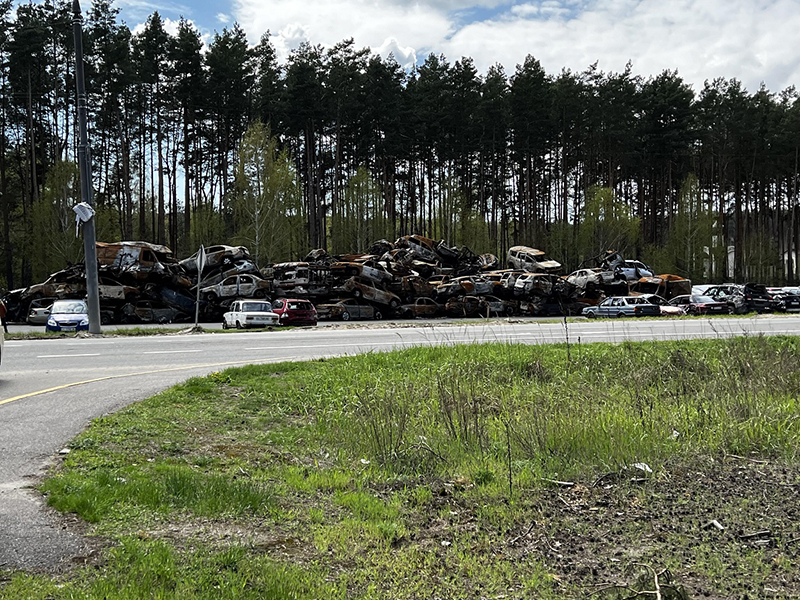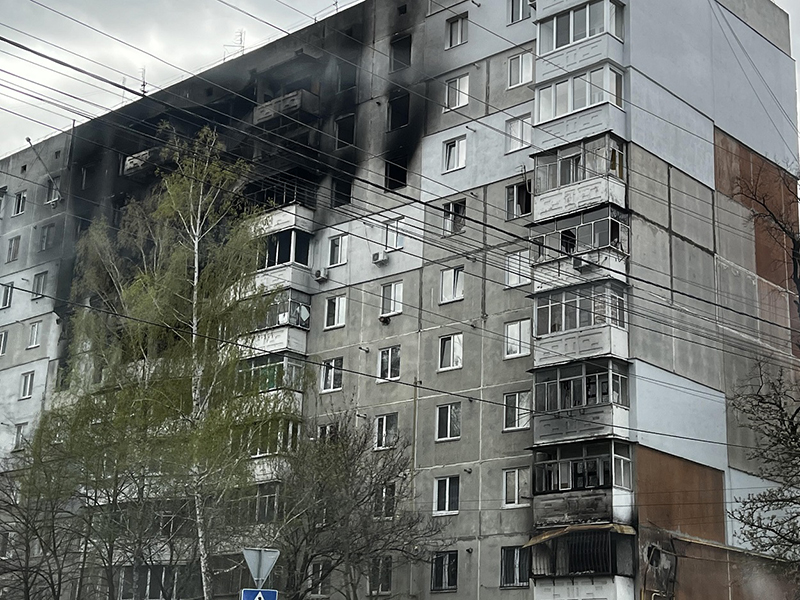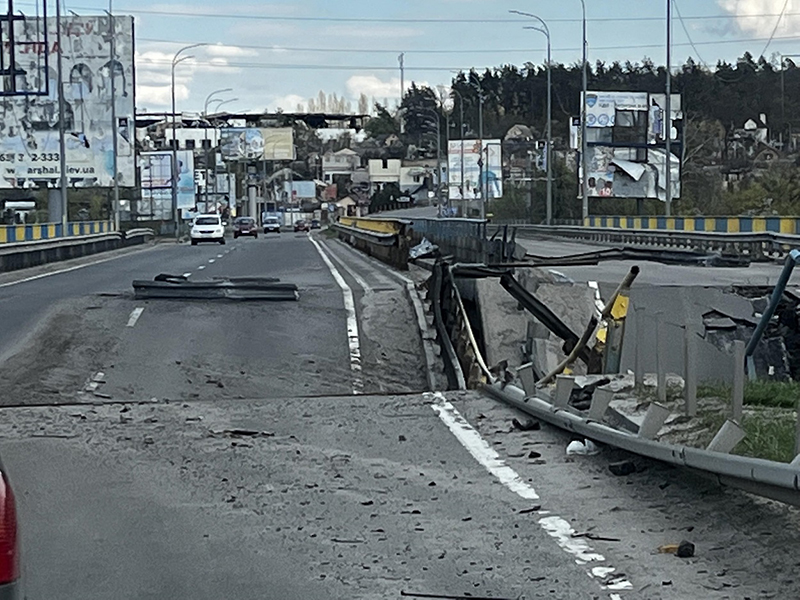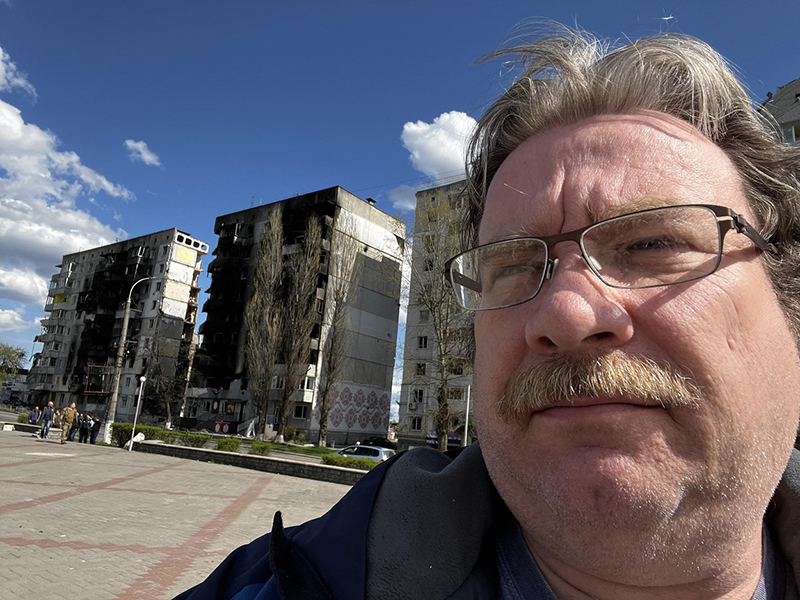By BRENT STAINER
Right or wrong, I’ve always imagined the fire service in a war zone to be analogous to the London Blitz of World War II, with firefighters in their leather helmets and slick raincoats dragging canvas hose and solid-bore nozzles across piles of rubble. I’ve watched the black and white newsreels as fire crews struggled with an inadequate water supply and access problems; it was sometimes difficult to determine what they were trying to save.
A recent experience has challenged my perspective, especially within the modern fire service and with modern military weapons. With very few yet notable exceptions, we have little to no experience with firefighting in a war setting.
A War-Like Experience
On the morning of 9/11, I was an engine company officer. On that day, we did feel like we were at war. Without question, those involved in the Oklahoma City and Boston Marathon bombings also have an unfortunate taste of war. None of this compares to the current events happening in Ukraine. I found myself, quite by accident, speaking with a firefighter (who requested I not use his name) in the city of Irpin, a suburb of Kyiv. We were standing on the ground floor of a church that had been struck by a bomb late in the fighting; the bomb eliminated the top floor. The stairway next to me led nowhere except to the sky (photo 1). Firefighters the world over share a bond, and I knew I needed his perspective. Fortunately, his English was far better than my Ukrainian.
As of this writing, the war between Ukraine and Russia lingers on, but you may recall that, in late February 2022, the Russian military was attempting to encircle Kyiv to hasten Ukraine’s surrender. As a part of that offensive, Irpin and Bucha were under Russian attack and subsequent occupation. Before I had met my Ukrainian friend, I had already witnessed the devastation throughout the city; nothing went unscathed. Every building was damaged, and most were still occupied despite the destruction. My visit was a couple months after the battle, and all the fires were out, but the clear burn patterns remained. Most of the destroyed passenger cars were collected into an open field (photo 2), but much of the destroyed armor remained. Evidently, it is too big and heavy to be a priority to remove.
I felt a little guilty taking photos, like I was invading their privacy, but I was struck by what I saw from a firefighting perspective—many of the high-rise buildings clearly had good stops on the fires (photo 3). Building construction played an important role, but there was clear evidence that firewalls were defended during fire attack and the bulk of the building was saved.
Kyiv is a modern city, not dissimilar to Everett, Washington, where I’ve served for 30-plus years. It has an excellent highway system, gas stations on every corner, and the ubiquitous McDonald’s. However, this McDonald’s had a sandbag air raid shelter in the parking lot (photo 4).

(1) The second floor of this church was destroyed by artillery fire during the battle for Irpin. (Photos by author.)

(2) Destroyed cars were unceremoniously piled up in an open field in Bucha.

(3) Stray missiles and artillery rounds started fires throughout the battle of Irpin.
So, when I met the Ukrainian firefighter at the bombed-out church, I was already primed with many questions about their efforts during the battle. The firefighter confirmed what I would expect of his fire department, based on my observations of Irpin. They are a modern firefighting service that uses the same tools as we do in North America: modern self-contained breathing apparatus (SCBA) and personal protective equipment (PPE), good pumpers, and a couple of ladder trucks. They have a well-developed water supply that uses hydrants and 1,000-gallon tanks on their engines.
My questions to him must have sounded disjointed, but I started with the most obvious: “How did you choose what fires to fight?” He smiled and said, “Whichever one the chief tells us to.” He then described more about the triage process; although he didn’t use that word, he explained how their chief would evaluate the extent of the fire, its location, the available resources and equipment, and staffing needs, then compare it with other fires (photo 5). He would then do the best he could for as many as possible with his limited resources. There were building fires they chose to not fight and others where they committed their resources. Some decisions were not popular, but the chief was still the chief, even in eastern Europe.

(4) A Kyiv McDonald’s, where you can eat your Big Mac in a bomb shelter.

(5) Triage at a city level was critical to managing resources.

(6) Aggressive firefighting tactics kept destruction to a minimum.
As the firefighter continued to describe the process, I began to see clear correlations with wildland firefighting. I’d been in a similar position in Washington state during the Okanogan Complex Fire in 2015, when we had to choose which battles to fight and which to surrender. During that summer, I probably saved—and lost—more homes than in the rest of my career. The situation in Irpin seemed eerily similar, but the similarity ended there.
One of the Ukrainians’ favorite initial attacks on a building struck with artillery or a missile was with a rapid vent-enter-search (VES)-style approach using a ladder truck (photo 6). They would access units adjacent to the fire, search, and report back the best access for the hoselines. Sometimes, they simply stretched hoselines up the aerial.
One internal discussion they had was how much damage the aerial could take before they removed it from service. They decided that if it was damaged from shrapnel or gunfire, they would load it to its capacity at 0° elevation and full extension. If it didn’t fail, it passed their field test. Unusual? Yes. Remember, they are at war. However, most times, an aerial wasn’t an option. Many times, single-engine companies were tasked with a commercial fire that would, in my city, be a third- or fourth-alarm fire. They triaged and made their best decisions based on their limited information and best judgment. They also limited their firefighting activities to areas not directly engaged in combat. When I asked him to elaborate, his answer was simple: When there were Russian soldiers or tanks coming, they retreated to safer locations. However, if it was just artillery or missiles, then they would go fight the fire. I stared at him a bit incredulously: “Just artillery or missiles?”
He also shared some frustration with the Ukrainian military. They’ve certainly done a fine job of defending their homeland, but he wished there could have been better sharing of information. Many of the bridges in Bucha and Irpin were purposefully destroyed by the Ukrainian military in an appropriate effort to slow or funnel the Russian advance (photo 7). The firefighters in their heavy fire apparatus were caught off guard and had access restrictions that could have easily ended in their deaths from either military combat or driving off a demolished bridge.
Strange Sights
One of the oddities I observed in Ukraine was that destroyed bridges were often still in service for passenger cars (photo 8); I still don’t know quite what to make of it. Bridges were destroyed and partially collapsed, but then passenger vehicles would routinely continue to use them. There may be a 20-foot dip in the bridge’s roadway, and there may be gaping, unmarked holes big enough for your vehicle to fall to the river below, but thousands of vehicles each day continue to use them. My best guess is that, after demolition, temporary shoring was completed on some of the lanes of the bridges that allow lightweight vehicles to pass but not armored vehicles (again, it’s just my best guess).

(7) Most bridges surrounding Kyiv were purposefully destroyed by the Ukrainian military.

(8) Although “destroyed,” the bridge is still passable for the “not faint of heart.”

(9) Fuel is difficult to obtain, especially diesel.
Fuel supply was one of the Ukrainians’ largest logistical challenges. Most gas stations had no fuel whatsoever but, occasionally, they had either unleaded or diesel fuel (photo 9). However, there was usually a 20-liter limit on how much you could purchase. Just as the lack of fuel was a major factor in the Russian armor advance to Kyiv, diesel fuel was (and is) a challenge. In eastern Europe, passenger cars use diesel as much as, if not more than, unleaded gasoline. Of course, heavy vehicles use diesel almost exclusively; their fire apparatus had to compete in that market. They also have their own tanks and pumps, but that is a very short-term solution, and any extended plan for resupplying diesel will compete with the general market and the Ukrainian military. One solution they currently have in place is simply limiting responses to confirmed fires. Other calls for service get smaller, more fuel-efficient vehicles to investigate the need before an increase in alarm level.
After Irpin, I spent some time in Bucha, Kaharlyk, Sumy, and Dnipro; all had lessons to teach me. One of the tougher fire service lessons I had to learn was simply that we were not at the “top of the food chain.” In our circumstances at home, we enjoy the benefit of stopping the world as we deem fit with our bright lights, sirens, and air horns. It is (hopefully) a friendly rivalry between us and law enforcement as to who rules the scene. However, in war, this isn’t even a question. The military will do what they need to do, and all others will stay out of their way.
Here at home, I’ve been involved in exercises that hint that our own military has the same attitude. They will likely permit our involvement as long as we don’t get in their way. However, like it or not, their goals and desires will trump our own, and we are not accustomed to that attitude. In Bucha, we were working at a bombed-out school when additional cruise missiles struck several miles away. The locals didn’t even take notice. It is, unfortunately, becoming a way of life for them (photo 10).
I found Ukraine to be a vastly different scenario than what I’ve experienced before. Yet, there were similarities worth discussion. As briefly mentioned earlier, there were elements reminiscent of a large wildland fire. There is a sense of cooperation on a huge scale—everyone working toward a common goal. Firefighters from different jurisdictions, law enforcement, business owners, and other civilians were all working together to meet the threat. In my experience, I witnessed that cooperation during a 304,000-acre fire, similar to the war footing in which the military, firefighters, and Ukrainian people now find themselves.

(10) The building on the left was cleaved in two by a cruise missile.

(11) An Irpin apartment building apparently used for target practice.
Other Comparisons
Another comparison to this war is a major earthquake; this is especially true in Bucha and Irpin, where there was extreme destruction. Everything was damaged, and multiple streets were blocked. This was very comparable to a trip I made to Haiti following the 2010 earthquake that killed hundreds of thousands. The similarities were striking. The biggest lesson to me is that Ukraine has similar building construction types, comparable infrastructure, and fire departments akin to what we have in North America.
Although I hope that a similar event will never happen in my city, it is a natural question that I find myself asking: How would my department respond in a similar situation? No doubt, we would see the coalescing of union and administration, along with other city and neighboring fire departments; We saw that in 9/11, but what I can’t answer to my satisfaction is, Do we have the flexibility and ability to remain nimble during unprecedented events? Perhaps we do. My department performed very well under the ever-changing COVID-19 challenge, as did most of our neighboring departments (then again, no one was shooting at us).
Back in Irpin (photo 11), I was finishing up my conversation with my firefighter friend. We had to leave shortly, as we were going to be pushing curfew, which was a violation and a serious, potentially lethal offense. However, one of his final comments left me thinking about priorities within the fire service. I expressed to him my admiration to continue to serve the public under such extreme and unusual circumstances. His answer was characteristically low-key, very much like how most firefighters would respond. He said, “One of the toughest decisions wasn’t decided by our chief. He left our PPE choices up to us, individually.” I gave him a puzzled look, and he continued. “Some choices our chief wanted us to be able to make for ourselves. When we went into a fire while the bombs were falling or the missiles were flying, we would have to decide for ourselves what PPE we wanted to use. Should I wear my SCBA and fire helmet? Or my body armor?”
That gave me a lot to think about. Oddly enough, it also gave me a new appreciation for the firefighters during the London Blitz.
BRENT STAINER is a division chief (ret.) for the Everett (WA) Fire Department. He was also Everett’s director of emergency management. Stainer recently assisted a nongovernmental organization in Ukraine, distributing food throughout the country.

